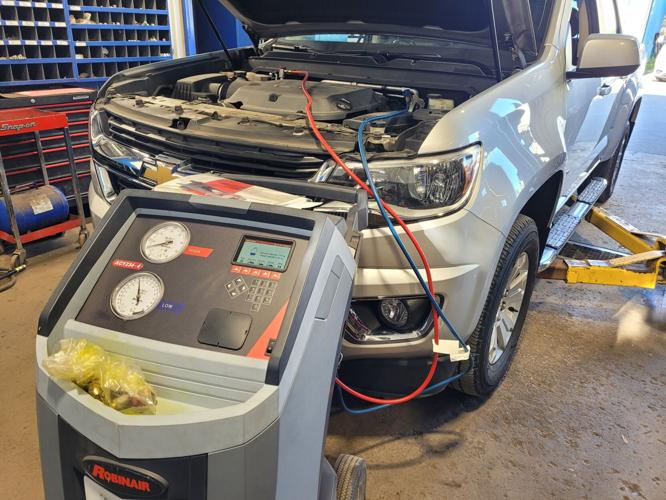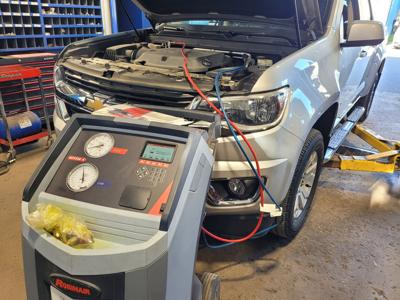Dear Ask A Mechanic,
I was talking with my neighbour the other night, and it turns out we’ve both just had the (air-conditioning) condensers in our Chevy pickups done.
His cost quite a bit more to do than mine, and he said that the repair shop told him that because his is a 2017, it uses “the new gas” that’s a lot more expensive.
My Silverado is a 2016, but our trucks are both half-tons with the 5.3 (litre V8) and look pretty much the same. I’m not upset that it cost me less to fix mine (it was still pretty expensive!), but I’m wondering if that’s really a thing.
Cool Dude
There is indeed a “new gas” that’s been adopted for use in what’s known as “mobile air-conditioning” — cars and trucks fall into that category, of course.
This isn’t the first time the industry has made such a change.
The earliest, factory-optional automotive air-conditioning system was the “Weather Conditioner” in 1940 Packards, although it would be decades before such systems became practical or popular.
Pretty much from the outset, however, mobile A/C (air-conditioning) used “R-12,” a refrigerant developed in part by DuPont, which marketed the gas as “Freon.” (Definitely a better choice than going by the product’s chemical name of “Dichlorodifluoromethane” ….)
R-12 provided chemical stability, was non-flammable, and was relatively efficient at transporting heat — a necessary characteristic, as all air-conditioning systems work by removing heat from the air being cooled and transferring it to an external location where it is radiated away.
Unfortunately, R-12 molecules contain chlorine atoms, and it was later discovered that when released through leaks or improper service methods, the gas would find its way into the upper atmosphere, where it would react with and destroy the stratospheric ozone molecules that help reduce the levels of harmful ultraviolet radiation that reach Earth’s surface.
In response to the resulting ozone “hole” discovered over Antarctica in the early 1980s, an international treaty called the Montreal Protocol was reached to address this threat, and alternative refrigerants were sought. By 1995, R-12 was phased out of new mobile A/C systems, replaced with ozone-friendly R-134a. (“Tetrafluoroethane,” in case you’re curious).
R-134a wasn’t a perfect solution, however. As we’ve become more aware of the risks of global warming, this replacement refrigerant’s “global warming potential” (GWP) — how much heat a given gas traps relative to carbon dioxide — has become an issue, as it is 1,430 times greater than the gas we already consider a problem. Although far better than R-12 (10,900!), it’s not ideal.
While various alternative refrigerants were proposed, including carbon dioxide, itself (ultimately unsuitable due to the extreme pressures required), the auto industry and regulators settled on “R-1234yf” (Tetrafluoropropene), co-developed by Honeywell and DuPont, as it is also ozone friendly and has a GWP rating of less than four.
Canadian regulations prohibit R-134a use in new vehicles as of the 2021 model year. General Motors was an early R-1234yf adopter, with the Silverado and GMC Sierra pickup twins switching to the new gas for the 2017 model year. Interestingly, in those models at least, the condenser — it’s the component located in front of the vehicle’s radiator — is the same, regardless of which refrigerant the truck is designed for.
(Although the two gasses are functionally similar, the oils used in the systems to lubricate the compressor are not compatible, and the service fittings are different to prevent the refrigerants being interchanged.)
To your original question: for those model years the labour required to replace the condenser is the same and the component itself is the same, so the main differentiator in cost would be the refrigerant; R-1234yf is significantly more expensive than R-134a — roughly two-and-a-half to three times as much, currently. Additionally, because the refrigerant handling equipment for R-1234yf is frequently costlier to buy and maintain, service facilities may factor this into the costs of the recharge as well.
The end result is that, unless the cost of the refrigerant drops over time (R-134a did, eventually), the air-conditioning in vehicles using R-1234yf will be more expensive to service and repair than the sum we’ve become used to over the past 30 years, and a single model year could make a difference of several hundred dollars.





























To join the conversation set a first and last name in your user profile.
Sign in or register for free to join the Conversation